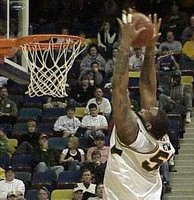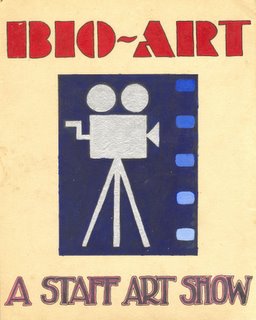 by Travis Charbeneau
by Travis CharbeneauAs our scene opens, we live much like our ancestors lived, in the fixed and perfect world God made. Then the aliens arrive. Their technology is nothing short of miraculous. Their values, to the extent they seem to have any, are appalling. We expect God to blast them at any moment, but He doesn't -- evidence of either God's favor or (can it be?) His impotence before the alien God/gods (again, if they have any).
But worst of all is the sheer culture shock: so many ancient assumptions abruptly dashed.
The Sun, for example, clearly circles the Earth -- yet the aliens convincingly demonstrate the opposite. Then they show how our obviously flat planet is in truth round. Further, Earth is not the center of the universe, but merely one of many worlds circling one of many stars. Perhaps worst of all, the aliens say we are not the center of the universe; not even mini-gods as we'd been taught for millennia. No, Man is just another animal ... descended from monkeys!
It's too much. We feel ... alienated. Our fixed and perfect world has been yanked from beneath our feet. We wish we could go back to the happy days before the aliens arrived. Their dizzying assertions and proofs are convincing, but even if they have the truth, we'd really prefer some comfort.
Minor variations on this scene replayed throughout the 15th century and Europe's "Age of Discovery." Columbus played the alien to indigenous America; Magellan to the Pacific. Etc. But less noted is the fact that the "Age of Discovery" itself was playing the alien to Europe. Beginning in that same 15th century with The Renaissance and continuing with Galileo, Newton, Darwin, we were speedily deprived of our flat Earth, our center at the universe, our divine exceptionalism. Natural science played the alien to Western Civilization. In many respects, Columbus was only marginally less befuddled by culture shock than the "Indians" he mistakenly discovered.
Natural science was sufficiently alien to the faith-based medieval mind that those who got too far out in front were burned as heretics. Unlike Galileo, Newton didn't face the Inquisition, but both overturned their respective worlds. Darwin likewise escaped the stake, but remains so radically offensive that many "moderns" still prefer comfort to his truth, just another skirmish in our notorious "culture wars."
The Bottom Line, however, has forever had the last word. However offensive, natural science enabled technologies that made for industries that created the Universal Comforter: wealth.
Natural science would therefore win many friends to further the terrible upsets of the Industrial Revolution, regularly overturning our world. From the Renaissance onward, humanity has been increasingly alienated by "too much change, too fast." In 1965 Alvin Toffler branded this variety of culture shock "Future Shock," and eventually published a best-selling book of that name.
"Future Shock" itself came as a shock, especially in America. Americans had invented the future. We loved the new and disdained "the Old World." Americans were supposed to take accelerated change as the norm and be very comfy indeed with the technology, consumerism and "progress" that had so powerfully raised our standard of living. And in 1965 we were still riding the crest of post-war prosperity and global economic hegemony. Apart from the stale Cold War, a new Civil Rights movement and early tremors from Vietnam, there wasn't much to be upset about.
Of course, "The Sixties" had not quite happened by 1965.
The Berkeley Free Speech Movement had only begun the previous December. The "Summer of Love" was two years off. What we'd come to see as the fruition of Beat sensibility, "the Movement" against "the Establishment," had yet to grow long hair and head out for the commune "back to Nature," a Hippie take on "traditional values." Among those values were doubts about technology and suspicion of consumption and "progress." The Sixties were very much an effort to come to terms with Future Shock.
In vital respects, the effort failed. Hippies morphed into Yuppies. Boomers came to power. Idealistic Aquarian values, to the extent they existed, were co-opted by orthodontia bills, tuition for the kids, and by 2005, the woes of retirement planning. Doubt and suspicion yielded to the Universal Comforter, plus stock options. But Future Shock persists and accelerates. Terrorists knock down New York.
We owe Communist China 242 billion dollars. Cell phones sprout from our very ears. The upset of "too much change, too fast" today provokes extreme "traditional values" reaction, complete with the old desire to "get back" to this or that Golden Age.
Western fundamentalists long for a return to the Fifties at least, if not some version of the 19th Century. Fundamentalists in the "Developing World," assaulted simultaneously by Western "progress" and the Future Shock that comes bundled with it, long for a return to the 10th Century. Neither can return even five minutes, leaving both to suffer violent, perhaps terminal nostalgia.
Should genuine, ET-style aliens land tomorrow, we might expect to be well-prepared as 500-year veterans of culture shock. But, clearly, we're not. Bred by natural science, the aliens have already landed, and they are us. And, despite all the nice, cozy money -- for those who have it -- many still prefer comfort to truth.
-- 30 --
"Travis Charbeneau is a freelance writer and musician living in Richmond, Virginia. As an essayist, Travis has written for Alternet and Copley News Service and appeared independently in Utne Reader, Newsday, Esquire Magazine, In These Times, The Detroit News, Keyboard Magazine, The Pittsburgh Post-Gazette, The Atlanta Journal-Constitution and many other periodicals. His essay 'My Story' won a 1985 PEN award."
 It’s the biggest stunt I was ever in on. The Devil and/in Miss Jones Prank went over so well, sometimes it’s hard to believe it really happened in Richmond, Virginia. “...To Stop Worrying and Love Getting Bombed” is a section of a work-in-progress to document the times of the Biograph Theatre. For April Fools Day here’s my story of a one-of-a-kind hoax -- performance art? -- that made headlines coast-to-coast in 1974:
It’s the biggest stunt I was ever in on. The Devil and/in Miss Jones Prank went over so well, sometimes it’s hard to believe it really happened in Richmond, Virginia. “...To Stop Worrying and Love Getting Bombed” is a section of a work-in-progress to document the times of the Biograph Theatre. For April Fools Day here’s my story of a one-of-a-kind hoax -- performance art? -- that made headlines coast-to-coast in 1974:












